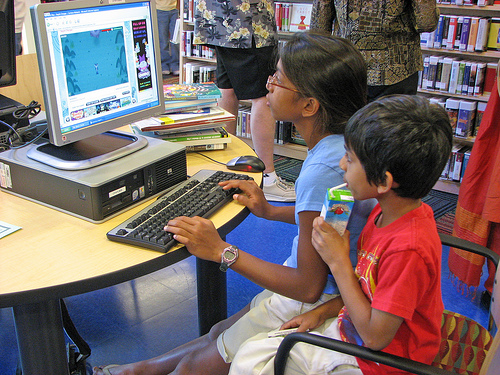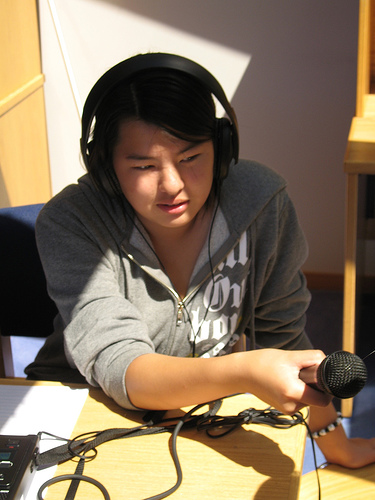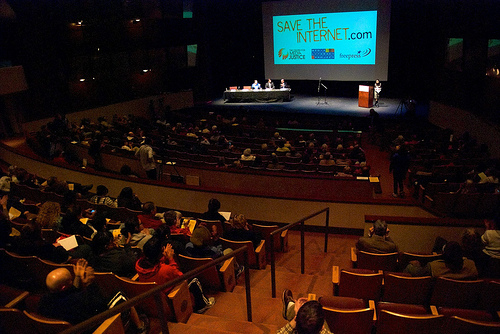New Media Rights has been reading and analyzing the recent FCC Future of Media Report. In May of 2010 we filed comments in the FCC's Future of Media proceeding, a proceeding that asked for opinion on everything from journalism to open standards on the internet. While many of the findings and statements do reflect how we believe media is transforming in America, we feel that the report lacks specific FCC goals and recommendations.
Organizations around the country took the time to share their experiences and expertise on journalism, radio, television, open mobile and internet standards, a worthy undertaking for the highest media regulatory agency in the United States. There was a staff-level group of journalists, entrepreneurs, scholars and government officials to collect over a thousand public comments, review existed research, and hold multiple hearings. This group was lead by Steve Waldman, a former reporter and founder of Belief.net who was commissioned to conduct the report.
We have broken our analysis into topics that we feel strongly about, and we have italicized quotes from the FCC Future of Media report:
FCC report should include more market wireless and broadband market analysis
An important element lacking from the report was a market analysis of the broadband and wireless market. This is critical in order for the FCC to create adequate decisions based on highly consolidated broadband and wireless markets that desperately need more competition to lower prices and open the door to digital inclusion. The looming AT&T merger will have a significant effect on prices and service availability in the wireless market, and a thorough study of the broadband and wireless markets would be helpful for the public to have greater transparency regarding the context in which the FCC is making its decisions.
New Media Rights has filed a petition to deny the merger with the FCC as well as filed comments to the CPUC about the importance of investigating the proposed AT&T T-mobile merger.
FCC should have laid out more ambitious goals
The FCC's published major findings and recommendations can be found here.
America's media landscape has gone through distinct changes as print media and radio try to thrive in the internet age. The FCC does a good job of addressing many of these changes in their report. We found that the report, however, does very little to chart a path forward, such as a strategy to improve the media system by increasing opportunities for non-profit and new media outlets through funding public and independent media creators, and fostering citizen journalism.
As the main federal agency to regulate national communications, the FCC should be more specific about tangible steps forward.
We have found this to be a similar issue at the California Broadband Council (CBC), (see the following paragraphs for more info on this council) where CBC praised Comcast for an FCC-mandated reduced price broadband (1.5 mbits down / 384 kbits up) option for low income consumers- which to us indicated the need for higher goal setting across the board at the state and national level. You can see our recent recommendations to the CBC on additional workgroups, an expanded definition of digital literacy, and making all data produced by the council public domain or openly licensed here.
We can't stress enough that to meet the challenges we face, we must set higher goals as a country for our media and communi cations system, and identify specific tasks to fulfill those goals so that America's communities and international competitiveness does not further suffer.
cations system, and identify specific tasks to fulfill those goals so that America's communities and international competitiveness does not further suffer.
Broadband and Wireless Buildout
The FCC’s 2010 National Broadband Plan sketched a strategy for providing high-speed access for 100 million Americans over the next decade. A key element of the strategy is to move communities toward less dependence on the two platforms that dominate today—cable and telephone wires—by encouraging the growth of the wireless Internet sector. This will expand access and, by bringing competition to the existing ISPs, potentially lower consumer prices. The plan also set a long-term goal for the United States to lead the world in mobile innovation and have the fastest and most extensive wireless networks anywhere. In early 2011, President Obama announced an initiative to make available fourth-generation high-speed wireless services to at least 98 percent of Americans. source: pg. 304
Things that could be improved:
How we build broadband out in America is critical and it's important to include community groups in this. New Media Rights' work with the California Broadband Policy Network (CBPN) in Sacramento has helped us better understand the various ways that community groups should play a critical role in expanding broadband to their communities. The California Broadband Council includes Assemblyman Bradford, Senator Padilla, representatives of various state regulatory bodies, and the chair of the council, president of the California Public Utilities Commisison, Michael Peevey. Peevey is a controversial figure who has come under fire from critics for rubber stamping energy regulation decisions at the CPUC.
The CA Broadband Council, established by Senate bill 1462, has been charged with the responsibility of deploying over $500 million funds for increasing the quality of broadband infrastructure in California, increasing public computer centers, and enhancing digital literacy.
New Media Rights and our CA allies including Media Alliance and Access Humboldt, have emphasized how important it is to include the voices of local community media centers, public access TV stations, technology groups and other community voices in the broadband buildout process.
Across the country, as stimulus monies are spent to promote digital inclusion, meaningful community group involvement and transparency on how monies are being spent will be critical. We must make sure that the process allows for individuals and groups in the community to share their needs.
Also, as we spend billions of dollars across the country to build out broadband, we should be discussing the need to, and the benefit of, retaining an ownership stake for the public that is paying for the buildout.
Without an inclusive process and retention of ownership for the public, carriers will simply find a way to use public monies to pad their bottom lines.
To read our comments before the Broadband Council see here and here.
Linking as a right: Copyright and IP
Today, of course, most linking happens without permission. Tim Berners-Lee, one of the inventors of the World Wide Web, has said that a link is nothing more than a digital referral or footnote, and that the ability to refer to a document is a fundamental right of free speech. source pg. 340
New Media Rights agrees with Mr. Berners-Lee on this topic and was particularly concerned about the State Department employees suggesting that even linking to the Wikileaks documents could hurt job seekers chances of working at the State Department. In a letter that we signed with EFF, the ACLU, and about 30 other organizations, we stated that internet users are protected under the First Amendment to publish 'truthful political information free of prior restraint' and publish information even if the 'original disclosure of that information to the publisher was unlawful, under Bartnicki v. Vopper'.
Also relevant here is the Protect IP Act, which the Senate Judiciary Committee has unanimously passed. This is a dangerous law that if passed could potentially trample on internet users rights to link to other websites. The Protect IP Act if passed would prohibit search engines from linking to blocked, blacklisted sites. This would be extremely detrimental to freedom on the internet as articulated in this linked articles by EFF.
As the Future of Media Report suggests, the shift from the paper medium to digital media has increased the opportunity to build sites that can include news articles and content created by other people. In fact, such sites, known as aggregators and filterers, are critical to our ability to find anything on the internet in the first place. A strong definition of what is in the public domain, and what is protectable by copyright, coupled with a strong Fair Use defense, will help make sure that those who help us find what we're looking for in a sea of content can continue to innovate.
Open Internet Standards
Some of the incipient optimism about media innovation comes from the emergence of small, independent, web-based news providers—precisely the sort that would be at a disadvantage in a tiered pricing system. A world without an open Internet would be one in which the very innovation we
are depending on to save journalism would lose its oxygen before it had a chance to flourish. source: pg. 307
In one of it's first references to the reports findings on the importance of an open internet, the FCC commissioned report recommends:
Universal Broadband and Open Internet are an essential prerequisite to media innovation and will make it more likely that digital media will be able to develop sustainable business models. source: pg. 33
We encourage the FCC to explore how their Net Neutrality rules might play a part in preserving this general cocept of openness and freedom on the internet. The key ways for the FCC to do this are to make sure that they 1) expand open internet rules to the wireless market, and 2) actually enforce their anti-discrimination rules against Internet Access Providers that discriminate against any web content or web/phone applications.
Compensation for news sources
 But as news organizations’ revenue dwindles, major news publishers point fingers at the vast numbers of websites they see “scrap[ing], syndicat[ing] and monetize[ing]” their original news content “without fair compensation to those who produce, report and verify it, and they wonder if changes to federal copyright and related intellectual property law policies can help stem their monetary losses. source: pg.340
But as news organizations’ revenue dwindles, major news publishers point fingers at the vast numbers of websites they see “scrap[ing], syndicat[ing] and monetize[ing]” their original news content “without fair compensation to those who produce, report and verify it, and they wonder if changes to federal copyright and related intellectual property law policies can help stem their monetary losses. source: pg.340
Again, we have to be careful not to over regulate and chill innovation of legitimate aggregating and filtering services that are critical to our ability to find information on the internet. See Art Neill's article on filtering aggregation.
New Media Rights supports start-up journalism ventures by offering free online publishing legal assistance, and also is very interested in helping bloggers and new journalism ventures be connected to emerging business models that help information dissemination and keep journalists employed. One thing that New Media Rights does not support is news organizations supporting "copyright trolls" to sue smaller forum websites and internet users, as in the Righthaven cases.
The strong lobbying power of corporate media makes their agenda and lobbying efforts more influential than individual creators. As an organization that respects the need for copyright reform, we encourage media companies to look elsewhere to grow their revenue, that does not include intimidation and threatening people's right to share and link to work.
FCC Transparency and Public Hearings
In addition, the Commission has recently taken steps to expand access to communications service, including mobile service, across the nation, for low-income consumers, Native Americans, and persons with disabilities. source pg. 308
There are at least 15 reservations in Southern California alone and we find it critical that these communities have a voice in their digital future and that rural communities and tribes have the same access to quality, affordable broadband can help expand educational opportunities, community health, as well as save lives in the case of an emergency.
We have also helped the Broadband Communities Coalition, which includes representatives of our regional tribes, to make filings (here and here) to the California Public Utilities Commission to ensure the tribes and other rural Californians are represented in the California Broadband buildout process.
Our friends at Free Press, Media Literacy Project and the Center for Media Justice, along with the FCC, organized a very successful FCC Future of Internet Hearing in New Mexico in November 2010. More than 400 citizens were present to comment to FCC Commissioners in hopes there wishes would be taken seriously by the FCC and Washington representatives. Citizens came out to emphasize the need for net neutrality and quality broadband access for education, health, creativity and equal opportunity.
New Media Rights encourages more public hearings as one viable avenue for the FCC to hear from individuals and group who are dealing with the lack of access to quality broadband.
Crisis Communications
Putting aside the debate as to whether it is appropriate for government to force device manufacturers to include FM chips as opposed to the parties working out commercial deals, we recognize that FM chips in mobile devices can provide a number of benefits to consumers. For example, they could enhance the value of the Public Localized Alerting Network (PLAN) during disasters; after getting a short text about the emergency, they could tune into radio news broadcast for more information (particularly if congestion on mobile networks or power outages make it hard to get on the Internet). source pg. 309
The FCC should be encouraging enhancement of crisis communications. Locally, Xavier Leonard has presented his Batphone, a phone that can communicate with other phones and create a mesh network if a crisis were to happen. Encouraging such innovation will be critical to helping communities respond to future crises.
Encouraging Digital Rights Advocacy
The future of media is the decentralization of media, billions of citizens finding an outlet for their ideas and creativity.
Knowledge of recording, publishing, intellectual property, privacy, and other laws, is critical to individuals' ability to interact with and create the media around them. We must find ways to fund one-to-one advocacy, educational materials, and innovative services that provide advocacy for the digital rights of individual internet users and creators. Empowering creators and internet users with regards to their rights will give us a richer media landscape in the future.
Other public interest organizations' analysis of the Future of Media Report:
Image sources:
"Children using computers at library" by Flickr user San Jose Library shared under Creative Commons Attribution-ShareAlike 2.0 Generic (CC BY-SA 2.0) License
"Untitled" by Flickr user Paul Goyette shared under Creative Commons Attribution-NonCommercial-ShareAlike 2.0 Generic (CC BY-NC-SA 2.0) License
"Untitled" by Flickr user Joaquinuy shared under Creative Commons Attribution 2.0 Generic (CC BY 2.0) License
"DSC_0081" by Flickr user sometimes drywall shared under Creative Commons Attribution-NonCommercial-NoDerivs 2.0 Generic (CC BY-NC-ND 2.0) License

